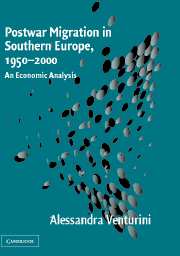Book contents
- Frontmatter
- Contents
- List of Figures and Tables
- Acknowledgments
- Introduction
- 1 The Evolution of Migration in Southern European Countries
- 2 The Choice to Migrate
- 3 The Effects of Immigration on the Receiving Country
- 4 The Effects of Emigration on the Country of Origin
- 5 The Effectiveness of Migration Policies
- References
- Index
1 - The Evolution of Migration in Southern European Countries
Published online by Cambridge University Press: 25 June 2009
- Frontmatter
- Contents
- List of Figures and Tables
- Acknowledgments
- Introduction
- 1 The Evolution of Migration in Southern European Countries
- 2 The Choice to Migrate
- 3 The Effects of Immigration on the Receiving Country
- 4 The Effects of Emigration on the Country of Origin
- 5 The Effectiveness of Migration Policies
- References
- Index
Summary
THE EVOLUTION OF MIGRATION
From Countries of Emigration to Countries of Immigration
Almost without its being noticed, the southern European countries have been turned from emigration countries into countries of immigration. This change was not sought, and in fact it was unexpected, as shown by the flurry of immigration legislation in the various countries, initially in Spain in 1985 and in Italy in 1986, later in 1992 in Greece, and in Portugal in 1993. This was designed to revise the immigration laws and regularize situations that had built up during the period when the authorities were taken by surprise and had not yet passed specific provisions. The decline in emigration from Italy, Spain, Greece, and Portugal took place before the 1980s. In fact the decrease occurred before 1974, the year when economic recession in the main northern European receiving countries led them to introduce restrictive immigration policies for foreign workers (see Figure 1.1). However, between the end of the 1970s and the beginning of the 1980s, the balance between inflows (+) and outflows (−) changed from negative to positive for all the southern European countries: Italy, Spain, Greece, and Portugal (see Table 1.1). In the case of Italy, especially, positive flows, counted in the thousands, first turned into tens of thousands and then hundreds of thousands.
- Type
- Chapter
- Information
- Postwar Migration in Southern Europe, 1950–2000An Economic Analysis, pp. 8 - 47Publisher: Cambridge University PressPrint publication year: 2004



